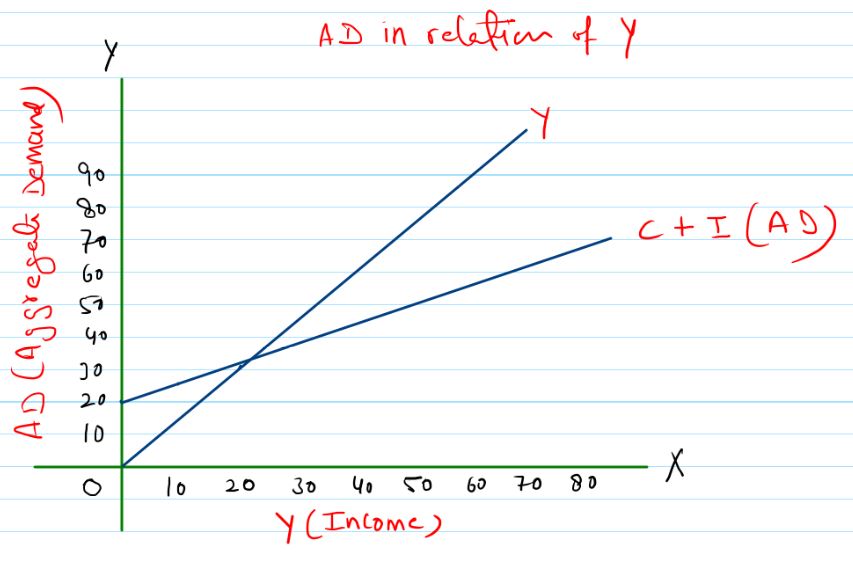What is Aggregate Demand Class 12, concepts, Components, curve
In this lecture, I am going to discuss what is Aggregate Demand, Its concept, components definition schedule, and its curve as per the syllabus of Macroeconomics class 12 CBSE Board.
All explanations are strictly only up to the syllabus prescribed by the CBSE Board for class 12.
Concept of Aggregate Demand (Class 12)
- Aggregate demand is one of the components to determine the Equilibrium of Income and Employment at the national level. Hence it is a macro study.
- AD does not refer to the demand for any particular good (or service) in the markets. It refers to the demand for all goods and services in the economy of a country at the national level.
- AD is measured for the period of an accounting year. So it is a flow concept.
- AD can be measured in two ways.
1) With reference to the general price level:- When AD is measured with respect to the general price level, It results in a negative relation between the price level and AD. AD curves slope downward.
2) With reference to the income of the people:- when AD is measured with reference to the income level of the people. It shows a positive relationship between income and AD. AD curves slope upward.
- In class 12, the study of AD is restricted with reference to the level of income. Hence, AD rises as the income rises, AD curve slopes upward, and vice-versa.
- AD is not measured as the sum total of physical quantities demanded in an economy. rather it is not possible to do so. Hence it is measured as the total expenditure on goods and services.
- AD is always expressed as what people plan (ex-ante) and wish to spend at a different levels of income. Never calculated as what people have actually spent on the purchase of goods and services in an economy.
What is Aggregate Demand class 12
In simple words, Aggregate Demand is the sum total of the value of all goods and services in an economy during an accounting year that all sectors of an economy are planning to buy.
Definition of Aggregate Demand (Class 12)
I am denoting various definitions of Aggregate word by word as given in different reference books. You can learn any definition out of below.
“AD is the sum total of expenditure that the people plan to incur on the purchase of goods and services produced in the economy (during the period of an accounting year) corresponding to their different levels of income”
T.R Jain
“Aggregate demand (AD) refers to the total value of final goods and services which all the sectors of an economy are planning to buy at a given level of income during a period of one accounting year.”
Sandeep Garg
“Aggregate demand refers to the total value of final goods and services that all sectors of the economy taken together are planning to buy at a given level of income during a period of time.”
S.K Aggarwal
Components of Aggregate Demand (Class 12)
Following are the various components of Aggregate Demand:-
Private Consumption Expenditure:-
Private consumption expenditure refers to the planned expenditure on final consumer goods and services by households at a level of income during a given period of time.
How much would be the expenditure by the households is influenced by disposable income available.
Investment Expenditure:-
Investment expenditure is the planned expenditure on new capital goods by producers during a period of time.
Investment Comprises expenses on:-
- Fixed capital business Assets:- Such as machinery, equipment, building etc.
- Inventory
- residential construction
Government Expenditure:-
Government expenditure is the planned consumption expenditure of the general government on providing free services to the people.
The free services include:-
- expenses on law and order
- Defense
- Education
- Health
- Sanitation
- Roads
Net Exports:-
Net export is the planned net expenditure by foreigners on the goods and services produced in the country during a period.
It is derived as
Net Exports = Exports – Imports
Behaviour and Schedule of Demand Curve
As we already have discussed. The aggregate demand is measured in terms of aggregate expenditure on the purchase of goods and services in the economy.
Thus the behavior of AD is studied in terms of the behaviour of aggregate expenditure at different level of Income (Y).
What does behaviour of AD Means:-
Behaviour of AD means, how aggregate demand responds to different level of Income (Y) in the economy.
It can be expressed by way of AD schedule as below.
| Y | AD |
| 0 10 20 30 40 50 60 | 20 25 30 35 40 45 50 |
Interpretation of AD behaviour:-
- There is always a minimum expenditure in the economy even if the income is Zero. As you can see in the above schedule at the zero levels of income AD is 20. The reason is obvious, in order to survive you have to buy some essential goods even if your income is zero.
- AD increases as Y increases. Thus, AD is positively related to Y.
- Initially, as Income increases, AD also increases at a higher rate. People buy goods and services to satisfy their wants. But after a certain level of income, AD, however, increases but at a slow rate. The reason is, at a higher level of income, people start saving a part of their income.
AD curve




A clear and concise explanation.